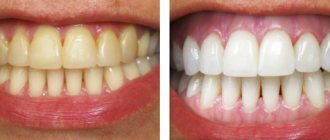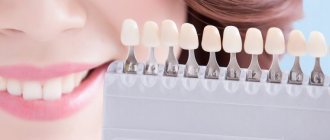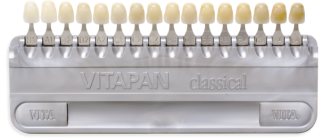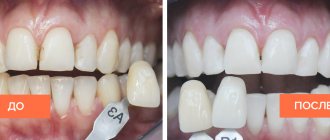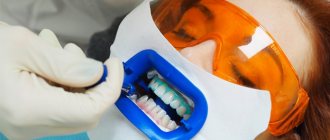Author of the article:
Soldatova Lyudmila Nikolaevna
Candidate of Medical Sciences, Professor of the Department of Clinical Dentistry of the St. Petersburg Medical and Social Institute, Chief Physician of the Alfa-Dent Dental Clinic, St. Petersburg
Cold lamp teeth whitening is one of the most modern ways to lighten enamel. The procedure is carried out using a special LED lamp with cold light.
This method is often confused with whitening with a conventional incandescent lamp, which heats the enamel, which is unsafe for the teeth, as it leads to their cracking, and also causes a lot of unpleasant sensations during the process itself. It is no wonder that patients are often distrustful of lamp bleaching.
The impact of an LED lamp is very different from a standard one; Let's figure out how effective and safe it is, and whether we should be guided by old stereotypes.
The essence of lamp whitening
It cannot be said that in this procedure, whitening occurs thanks to the light produced by the LED lamp. The bottom line is that light is only a catalyst for a chemical reaction between the reagent and the pigments that are inside the enamel and are responsible for its color.
In order to neutralize the yellow tint, a special gel based on hydrogen peroxide is applied to the teeth. Light exposure to this substance activates oxygen, which penetrates the tooth tissue and oxidizes pigments. Thus, light rays stimulate the chemical process, making the procedure safer and faster.
The main advantage of this method is that the light from the LED lamp practically does not heat the enamel, and therefore does not harm it.
Procedure technology.
Teeth whitening with cold light takes about an hour; first, the dentist must prepare the enamel, examine the oral cavity, remove stone and plaque. The process will be complicated by the presence of carious formations; they need to be cured and filled; there is no point in lightening damaged surfaces. It is also recommended that about a week before starting the procedure, you should exclude coloring foods from your diet and brush your mouth only with white toothpastes. If the patient has no diseases or contraindications that would interfere with whitening, the dentist can begin work.
Preparation.
For convenience, a special retainer is used - a retractor, which holds the jaw in the desired position. It helps the patient to relax his mouth and not tense during the entire procedure, and to prevent his lips from cracking, they are moisturized with cream. Exposure to a halogen lamp harms soft tissues, so liquid rubber dam is applied to them. It hardens within 20 seconds, isolating the gums from aggressive influences.
Lightening.
A special whitening gel is applied to the enamel and with the help of the rays of the Beyond device, the surface of the teeth begins to change. The interaction of peroxide and cold light occurs, active oxygen is released, which penetrates into the dentin, destroying dark pigments. After 10 minutes of treatment, the dentist removes the remaining substance and applies a new portion of the solution. This must be repeated three times.
Final.
Any cosmetic procedure affects the structure of the enamel; to restore it, after the action of the Beyond device, the surface of the teeth is covered with special varnishes and fluoride-containing pastes.
Cold teeth whitening: stages
Enamel lightening with gel and a lamp is exclusively an in-office procedure that should be performed by a trusted specialist. Otherwise, you risk damage to the enamel, irritation of the oral mucosa and other problems.
The whitening itself lasts about an hour and is carried out in several stages.
Preparation
Before any whitening, no matter which method you choose, you should prepare your teeth very carefully:
- Firstly, this concerns the elimination of various scratches and chips on the enamel, as well as the treatment of caries. If you don't do this, the active gel may get into the cracks and act too deeply on the tissue, which will cause you a lot of discomfort both during and after the procedure.
- Secondly, pay special attention to fillings and implants; their color will not change due to bleaching, so it is better to choose temporary options and install permanent ones after the procedure. Otherwise, the color of your smile will not be uniformly white.
- Thirdly, mechanical or ultrasonic cleaning is always necessary before whitening; it will remove soft and hard plaque from the teeth, which will help determine the natural color of your enamel as accurately as possible. Cleaning itself will make your smile one or two shades brighter. Next, you can choose the color of the enamel using a special VITA scale. Next, the bleaching itself begins.
Stages
- The first stage begins with preparing the oral cavity for the procedure; this is necessary to protect the soft tissues. The cheeks and lips are isolated using various napkins and films so that the gel does not accidentally come into contact with them when treating teeth. A protective composition is also applied to the gums so that the aggressive effects of the gel do not cause irritation and other problems. The most popular option is liquid rubber dam; the advantage of this composition is that it quickly hardens, forming a dense protective film.
- The second stage is the whitening procedure itself, the surface of the teeth is thoroughly dried and then evenly coated with the active composition. Next, the teeth are irradiated with an LED lamp for about 10 minutes and the gel is removed. If the color is not white enough, the procedure is carried out again. During one visit to the dentist, it is possible to make no more than three approaches.
- Special restorative compounds are applied to the teeth.
The whole procedure takes about an hour. The result is individual for everyone, so do not despair if you did not get the desired color on your first visit; most likely, with repeated procedures you will achieve the desired shade.
How we do whitening
| Step 1 Our doctor will tell you about the teeth whitening process, discuss possible and expected results, and answer any questions you may have. Then he will conduct a thorough examination to make sure that whitening is indicated for you, determine the color of your teeth and record it for comparison with the new color. |
| Step 2 Your doctor will install a cheek retractor and tell you to wear safety glasses. To prevent dry lips during the procedure, we use a special lip balm. |
| Step 3 The doctor will apply a special protective gel between the teeth and gums, which will then be illuminated with a lamp (the gel will become rubber-like and will protect the gums from the bleaching agent). |
| Step 4 The doctor will unpack the original Beyond II or Beyond MAX syringe in front of you. |
| Step 5 The doctor will apply the whitening gel to the upper and lower teeth, completely covering the surface of each tooth. |
| Step 6 The Beyond accelerator lamp will be brought to your teeth. The doctor will turn it on for 12 minutes, and the entire procedure will consist of three such cycles. |
| Step 7 After completing three cycles, all whitening materials will be removed from your mouth, and in the mirror you will see a completely new color of your teeth, significantly different from your usual one. |
How effective is teeth whitening with LED light?
Modern cold bleaching is a very effective method. Depending on your individual characteristics, in one visit to the dentist you can lighten your tooth enamel by about 6-10 shades. Provided that your teeth have acquired a yellow tint due to food or smoking. If your enamel has acquired a gray tint, lightening with an LED lamp will not give significant results, that is, the shade will change by 2-3 tones. In addition, the procedure will not work if a change in the healthy color of the enamel is caused by taking tetracycline antibiotics or an excess of fluoride in the body.
The results of whitening with an LED lamp can last for several years, depending on the natural shade of the enamel and how carefully you follow your dentist's recommendations.
Benefits of home whitening
Gentle drugs. Home systems use the same active ingredients as preparations for professional use in a dental office. The difference is in the concentration of such substances and the period of their action. When whitening at home, the contact of the enamel with the bleaching agent lasts from 1-2 to 8 hours. The procedure is repeated several times. Hydrogen peroxide or carbamide peroxide in low concentrations act slowly, gradually, and do not destroy the enamel or increase its sensitivity.
Activation due to a chemical reaction. During in-office bleaching, the active composition can be activated by a lamp. If the dentist makes a mistake at this stage, the pulp may overheat and dehydrate the tooth tissue. Home systems do not have such risks: the lamp is not used, and the active composition is prepared immediately before application. It contains an increased amount of water so that the chemical reaction and the action of the whitening agent do not dehydrate the tooth tissue.
Convenient to use. The patient carries out all procedures himself. For this purpose, elastic mouthguards are used. The product is placed inside them, the trays are put on the teeth and worn for several hours. Daytime whitening systems require wearing for 1-2 hours (the concentration of the active substance is higher). When using night systems, the patient puts on the trays at night, and the gel works while he sleeps.
Stable result. Lightening is carried out gradually, the shade of the enamel changes after each use of the tray. The patient can track and control the lightening of teeth independently. The results of the procedures are stable and with proper care can last for years.
Why does tooth enamel darken?
To get the most out of lamp whitening, you need to understand the causes of darkening of tooth enamel. In most cases, it is enough to eliminate the negative impact and clean the teeth so that the color of the teeth becomes natural again.
Dentin has a dark shade, which shines through a thin layer of enamel. A fair question arises: how does it happen that dentin darkens if the enamel is strong and can protect the tooth from many negative factors?
The reason is quite simple. It lies in the universal love for solid foods and sour drinks. Seeds, nuts, lemonades and other similar products contribute to the deformation of the upper layer of teeth. Through scratches and chips, pigments easily penetrate into the tooth tissue, staining the dentin.
The main factors influencing the color of teeth:
- The most popular reason is the consumption of foods that contain large amounts of coloring substances. These can be the following things: cranberries, blueberries, beets, strawberries, various candies and sodas, coffee, strong tea and much more. If this is the reason for the darkening of your teeth, then careful hygiene and periodic professional cleaning (once or twice a year) will help.
- Change • Change in enamel color is common in smokers. The main problem here is the tar that is in the cigarette. Together with smoke, they fall on the surface of the teeth and settle in the form of a dark plaque. Gradually, this sediment destroys tooth enamel, which can lead to caries and more serious diseases. In addition, smoking also has a negative impact on your gums. The best option in this case would be to quit smoking completely. If this is not possible for you, try to reduce your cigarette consumption to a minimum and pay more attention to oral hygiene.
- The tooth may darken due to injury, which led to damage to the neurovascular bundle. In this case, consultation with a specialist is necessary. Until the cause is eliminated, whitening will not help lighten the tooth.
- The shade may change due to the removal of the nerve; the darkening may not appear immediately, but also requires the intervention of a specialist.
- Filling a canal can lead to staining of the enamel; it all depends on the material used to fill the hole.
- Progressive caries is an advanced case of ordinary caries. The fact is that if such damage is not eliminated, small black spots will increase, destroying the enamel and then the dentin.
- Teeth may have congenital characteristics that are in no way related to caries or other damage. They can differ in structure, tone, shape, and so on. In some cases, it is possible to change their color only with the help of special overlays - veneers.
- Excess fluoride in the water you drink can lead to fluorosis. At the beginning of the disease, dark spots or chalky streaks appear on the teeth. The progression of the disease leads to the destruction of enamel and then dentin. Whitening such teeth is not possible until you get rid of fluorosis.
- Taking tetracycline antibiotics during pregnancy can negatively affect the condition of the baby's teeth.
Professional laser method
Laser whitening is performed in the dentist's office and is not much different from photo whitening. The difference is that the gel applied to the surface of the teeth begins its action not under the influence of light, but under the influence of a laser. Many experts recognize this method as the best among other types of whitening. But patients themselves leave different reviews regarding laser lightening. But in any case, a consultation with a dentist is necessary, since the laser method also has a number of contraindications.
Benefits of lamp teeth whitening
The main advantage of the LED lamp, which is used for teeth whitening, is the almost complete absence of harm to the patient. This method has passed all clinical trials and is considered one of the safest. Radiation from the source passes through a special filter that neutralizes the negative effects of ultraviolet and infrared radiation. The temperature of the enamel surface during the procedure does not exceed 37.6ºC.
You can also note other advantages of cold whitening:
- Short procedure time;
- The ability to get the desired result in one go;
- The active gel applied to the teeth has a special composition that helps reduce sensitivity to the procedure.
- The system allows you to whiten teeth that have darkened with age or their color is a consequence of fluorosis.
The disadvantage of the procedure is its high cost and a long list of contraindications.
Whitening and Professional Cleaning: Similarities and Differences
Professional cleaning is a mechanical removal of plaque; it does not change the shade of the teeth and is a preparatory step before whitening. Whitening consists of a chemical effect on the pigmentation of teeth, their surface changes its shade to a lighter one.
Types of whitening:
- professional - effective and fast way;
- homemade (using trays and whitening gel) - at home this is a long process that can take several months, it is not always possible to achieve a noticeable effect;
- intracoronal - performed on an individual tooth when its shade changes, the indication for which is trauma or endodontic treatment.
Professional whitening takes a little over an hour. The doctor uses special equipment (lamp, laser). It is designed to activate the gel. Philips Zoom lamp whitening! WhiteSpeed (Zoom 4) can change the color of enamel by several tones in one visit to the doctor.
Contraindications
You should not resort to whitening with an LED lamp in the following cases:
- high sensitivity of teeth;
- defects on enamel;
- pregnancy or lactation (there are other methods);
- intolerance to the active components that make up the gel;
- fixed dentures, crowns or a large number of fillings;
- The procedure is also not recommended for children under 16 years of age;
- caries, periodontitis and other diseases.
In the latter case, the ban is temporary, since the procedure can be carried out after you have treated your teeth.
Types of whitening and contraindications
A dentist will help you choose the optimal whitening method for each patient. He will find out the reason why the teeth changed their color and interview the patient about contraindications:
- children under 18 years of age;
- any trimester of pregnancy;
- lactation period;
- individual allergic reaction;
- multiple fillings, prosthetics in the smile line (if the patient does not plan to change these fillings and crowns in the future).
Before you start whitening, you need to perform oral hygiene. Exposure to the Philips Zoom lamp! WhiteSpeed (Zoom 4) is suitable for most patients, but you must get your doctor's approval before using it.
How to save the result
Once you've gotten the whiteness you wanted, don't forget that your teeth now need more careful care. For a week, it is best to follow a clear (white) diet, the essence of which is to exclude coloring or very hot foods. It is also better to reduce your cigarette consumption.
In addition, professional products from the ASEPTA series for oral care will help you. They will prevent the appearance of yellow plaque, caries and other troubles, for example, ASEPTA Sensitive toothpaste will help reduce tooth sensitivity after the procedure. In the future, you can use ASEPTA PLUS Remineralization or Gentle Whitening toothpaste to maintain a snow-white and healthy smile.
Sources:
- Report on determining/confirming the preventive properties of toothpaste “ASEPTA PLUS” GENTLE WHITENING” Author: doctor-researcher A.A. Leontyev, head Department of Preventive Dentistry, Doctor of Medical Sciences, Professor S.B. Ulitovsky First St. Petersburg State Medical University named after. acad. I.P. Pavlova, Department of Preventive Dentistry
- Report on the determination/confirmation of the preventive properties of personal oral hygiene products “ASEPTA PLUS” Remineralization doctor-researcher A.A. Leontyev, head Department of Preventive Dentistry, Doctor of Medical Sciences, Professor S.B. Ulitovsky First St. Petersburg State Medical University named after. acad. I.P. Pavlova, Department of Preventive Dentistry
- Clinical studies of antisensitive toothpaste “Asepta Sensitive” (A.A. Leontyev, O.V. Kalinina, S.B. Ulitovsky) A.A. LEONTIEV, dentist O.V. KALININA, dentist S.B. ULITOVSKY, Doctor of Medical Sciences, Prof. Department of Therapeutic Dentistry, St. Petersburg State Medical University named after. acad. I.P. Pavlova
- Report on determining/confirming the preventive properties of toothpaste “ASEPTA PLUS” COFFEE and TOBACCO Author: doctor-researcher A.A. Leontyev, head Department of Preventive Dentistry, Doctor of Medical Sciences, Professor S.B. Ulitovsky. First St. Petersburg State Medical University named after. acad. I.P. Pavlova, Department of Preventive Dentistry
Recommendations after teeth whitening zoom 4
To avoid pain after zoom teeth whitening, be sure not to neglect the doctor’s recommendations. If you require a course of remineralization therapy before you even think about aesthetics, this is the surest way to prevent tooth sensitivity after the procedure.
But it often happens that teeth hurt after zoom whitening, even if the strength and mineralization of the enamel was not in doubt. This can be explained by the fact that the tubules passing through the thickness of the enamel and dentin became free again, and therefore began to actively conduct irritants to the pulp - the “brain” of the tooth.
From the outside it seems that the enamel is hard and impregnable, but in fact it is all dotted with tubules that come to the surface as pores. When we eat food (sweet, salty, sour, etc.), the fluid inside the tubules begins to move osmotically. This causes a reaction - pain.
What to do? How to relieve pain after zoom teeth whitening?
Try to avoid provocations - do not eat sour, salty, sweet, hot, cold foods. Over time, the pores on the surface of the enamel will close somewhat. And after each teeth whitening session, the dentist will apply a remineralizing agent, which will make the dental tissues stronger and more resistant to various irritants.
White diet after teeth whitening zoom
To prevent the pores in the enamel opened with the help of a chemical agent and laser from absorbing new pigments from food, it is recommended not to eat colored foods for the first time after a teeth whitening session.
Food pigments are found in all vegetables, fruits, and drinks that have a color other than white. That’s why this diet was called “white”.
The diet after teeth whitening zoom 4 may consist of dairy products, mushrooms, bananas, peeled apples and pears, cauliflower, potatoes, white cabbage, pasta and other dishes made from white flour, white fish, poultry, rice, pearl barley, oatmeal, beans , eggs (without yolk).
As you can see, you can maintain a sufficient amount of proteins, carbohydrates and fats in your diet to obtain energy and maintain processes necessary for beauty and health.
Is there any harm in zoom teeth whitening?
Could such gentle and non-aggressive zoom teeth whitening have disadvantages?
Of course, if the tooth tissue does not have a structure sufficiently saturated with minerals, each new enamel lightening session will cause irreparable damage. Teeth can become not only too fragile, but also hypersensitive.
Also, teeth whitening zoom 4 is harmful for those who do not have sufficient willpower. In order to adhere to the correct diet, strict self-control is needed. If you do not adhere to the recommendation regarding choosing products without pigments, your teeth can become even more stained.
Despite its high safety, zoom 4 teeth whitening also has contraindications. The procedure should not be performed if:
- pregnancy, breastfeeding;
- oncological diseases;
- increased sensitivity of enamel;
- caries and gingivitis;
- the presence of large fillings and prostheses of the front teeth.
All contraindications for zoom teeth whitening can be reviewed separately, because each clinical situation is individual.
Teeth whitening price zoom 4
The cost of zoom 4 teeth whitening depends on the system used during the session. The price is also influenced by the reputation of the clinic and the doctor, as well as the professionalism and experience of the dental staff. Prices in clinics that are located closer to the city center or busy, popular places are also higher.
If you would like to get a good discount, you can use coupon sites. Thus, clinics and beauty salons often try to attract more people. Look for coupons or certificates that say “Teeth whitening zoom 4: promotion!”
But how much does zoom teeth whitening cost approximately? The price of the course is between 10-25 thousand rubles. Home systems for self-use are cheaper, but they contain a gel with a lower concentration of the active substance, so they whiten teeth much more slowly.
In addition, even if the cost of zoom teeth whitening seems significantly higher than using a home system, it is worth remembering that in addition to the set of gel and lamp, it is recommended to make an individual mouth guard. This will allow you to use the gel sparingly, as well as surround the teeth more tightly with the drug.



